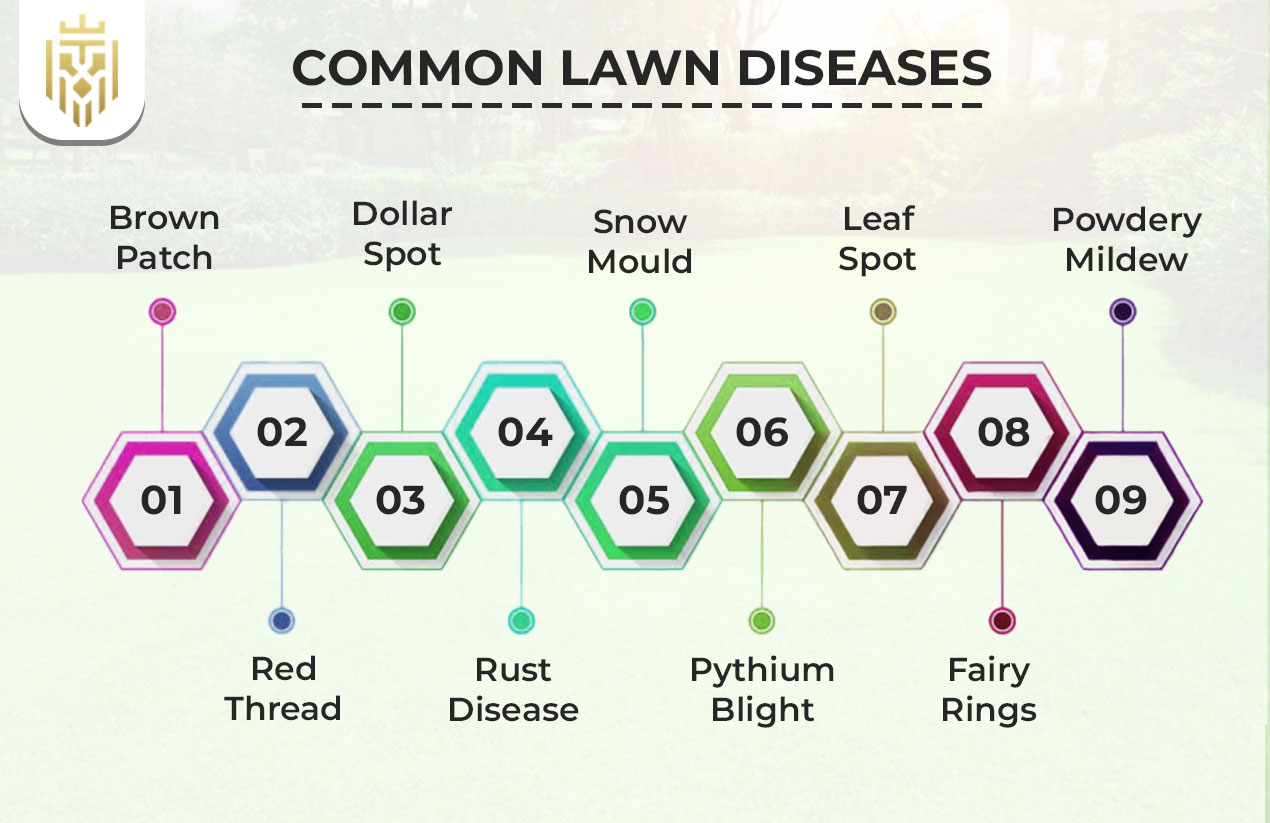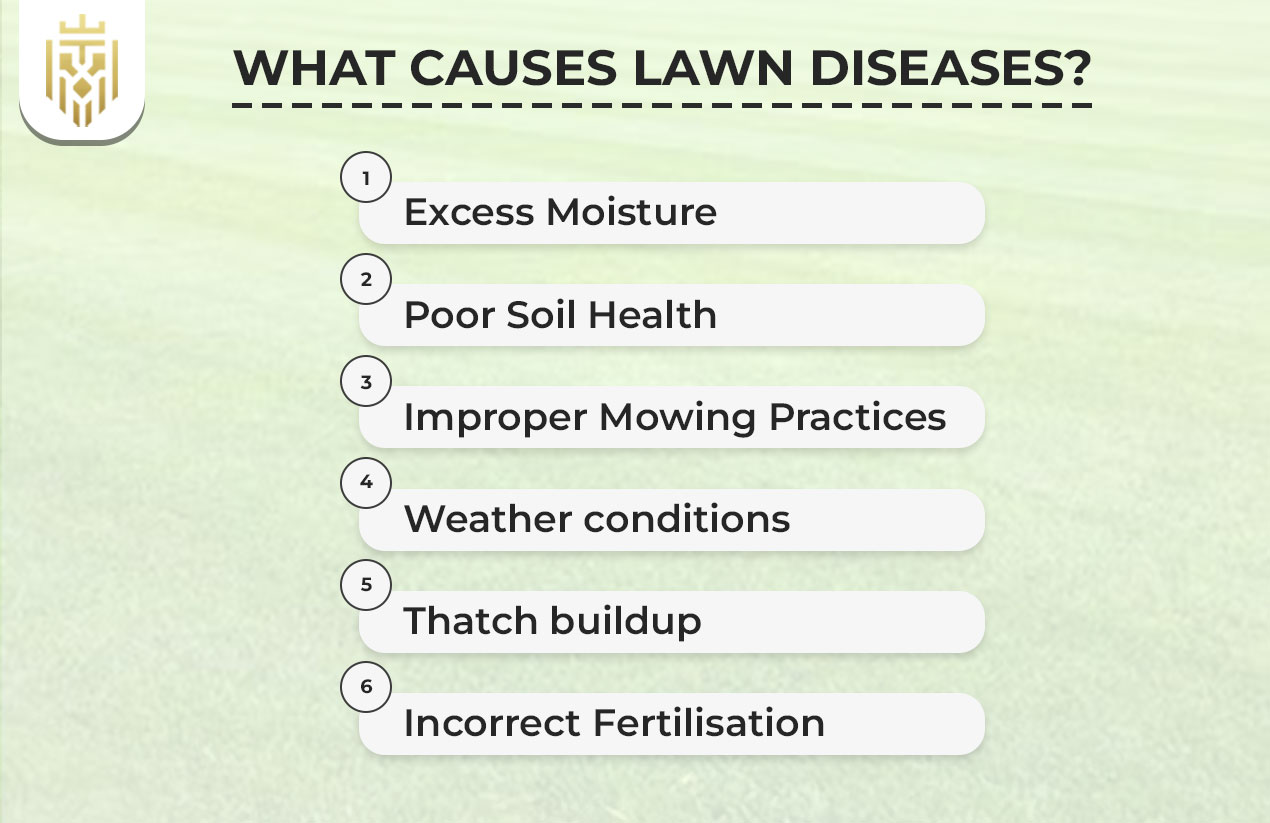What Are Lawn Diseases?
Lawn diseases are problems that occur due to fungi, bacteria, or environmental stress and thereby adversely affect the health, colour, and density of grass. These ultimately discolour and patch out the grass, and in severe cases, could lead to large patches of dead turf. Early identification of these diseases is essential to avoid permanent damage.
Common Lawn Diseases

Lawns can be affected by a range of diseases that vary in appearance, severity, and the conditions they thrive in. Here are some of the most common lawn diseases to watch for and recognise early.
Brown Patch
Brown patch is a fungal disease that develops during warm weather and an increase in relative humidity, forming circular brown or yellow areas on the lawns. The affected patches most often tend to enlarge quickly, leaving unhindered irregular shapes all across the grasses.
Red Thread
Red thread-diseased lawns are characterised by the presence of reddish to pink fungal threads holding the grass blades together. It usually occurs in nutrient-deficient lawns, particularly those low in nitrogen.
Dollar Spot
Dollar spot produces round straw-coloured spots, smaller than the size of a coin. It prevails in lawns with scanty fertilisation and disseminates mostly under warm and moist situations.
Rust Disease
Rust disease colours the grass blades orange or rusty, while the powdery spore deposits get transferred on shoes or equipment. It usually develops in slow growth periods in the shade or damp surroundings.
Snow Mould
Snow mould appears after the snow has melted, so it is a matted grass with a white or pink fungal coating. It is developing if the snow covers unfrozen ground for a long time, allowing the fungus to grow beneath.
Pythium Blight
Pythium blight is a fast and deadly disease in hot, humid weather, growing up greedy and water-soaked cashes from very fast dead areas.
Leaf Spot
Small dark-disabled grass blade lesions turn tan with reddish margins. These cause more thinning and, in strong incidents, damage to the crown and roots.
Fairy Rings
Fairy rings create dark green arcs or circles of grass that sometimes get bordered by mushrooms. They are the consequence of the fungal growth in the soil, disrupting the usual look and the vigour of lawns.
Powdery Mildew
Powdery mildew coats grass blades in this very fine texture of white powder; it usually happens where it is shady and damp. It weakens the lawn with time, thus slowing down photosynthesis.
What causes lawn diseases?

Lawn diseases can develop due to a combination of environmental factors, lawn care mistakes, and soil conditions. Below are some of the most common causes that make lawns vulnerable to infections.
Excess Moisture
Constantly wet conditions suit fungal spores perfectly to multiply. Overwatering and bad drainage are common reasons.
Poor Soil Health
Deficient in essential nutrients or compacted, the soil hampers healthy grass growth, hence making the lawn more vulnerable to diseases. Good soil holds strong root systems that can fight against infections.
Improper Mowing Practices
Mowing at too low a height or exacerbating the grass with dull mower blades puts it under stress. This weakens its defences, thus creating an opening for diseases.
Weather conditions
Prolonged humidity, heat, or cold are responsible for setting off certain diseases. Similarly, the changes in season sometimes govern the fungi that should be active.
Thatch build-up
A thick layer of thatch stores moisture and provides fungi with good breeding grounds for the spread of diseases. De-thatching when necessary checks the build-up.
Incorrect Fertilisation
Inappropriate fertilisation amounts work in tandem to stress the lawn, thereby disturbing its normal state. Excess fertilisation promotes the type of growth that is susceptible to diseases, whereas insufficient fertilisation does not produce a strong turf.
How to Prevent Lawn Diseases?
Keeping lawns healthy and resilient requires a combination of proper maintenance and proactive care. Here are some effective ways to reduce the risk of lawn diseases.
Water deeply and infrequently
Watering less frequently but deeply promotes deep root development. It also prevents the surface from remaining wet, which fungi prefer.
Mow at the correct height
Keeping grass at the industry-recommended height develops its resistance against disequilibrium. Avoid scalping, as it damages the grass and exposes the soil.
Fertilise properly
Good fertilisation keeps lawns healthy and more resistant to infection. Following a fertiliser schedule helps maintain regular growth through the seasons.
Control thatch build-up
Aerating and de-thatching regularly stimulate air and water circulation in the soil. And this makes for an environment unfavourable for fungi.
Improve Soil Health
The addition of organic matter plus correct pH bestows strength upon the lawn. Weak soils allow no beneficial microorganisms that inhibit pathogen effects.
Choose Disease-Resistant Grass Varieties
By selecting the grass variety that suits the local climate and conditions, the chances of recurring infections are somewhat lessened. These varieties are better able to withstand the threats than others.
Promote Good Air Circulation
Trimming nearby shrubs and trees increases airflow, reducing excess humidity on grass surfaces. Well-ventilated lawns dry faster after rain or watering.
Monitor Regularly
Inspecting lawns often helps catch problems before they escalate. Early detection allows for quick intervention and treatment.
FAQs
1) What Are Lawn Diseases?
They are conditions with fungi, bacteria, and environmental stress that affect the health, colour, and growth of grass.
2) How to Prevent Lawn Diseases?
Regular lawn care, proper watering, correct mowing, balanced fertilisation, and monitoring are the main ways to prevent lawn diseases.
3) What causes lawn diseases?
They would be caused by the excessive moisture, bad soil health, incorrect mowing, thatch accumulation, wrong fertilisation, and climatic conditions.
4) What are the common lawn diseases?
Brown patch, red thread, dollar spot, rust disease, snow mould, pythium blight, leaf spot, fairy rings, and powdery mildew.









